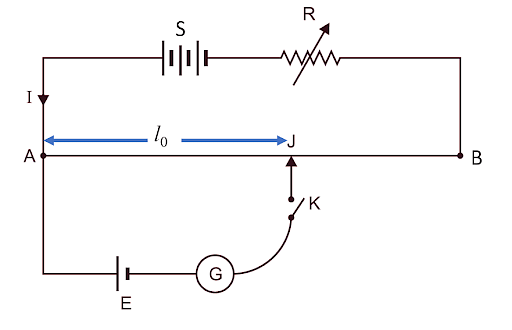Collegedunia Team Content Curator
Content Curator
Potentiometer is an important topic covenant in the Current Electricity Chapter of the CBSE Class 12 Physics Syllabus. This article covers the important questions based on the working principle, construction, types, and characteristic properties of potentiometers used in electrical circuits.
Potentiometers are passive components of the electric circuit that work on the principle of changing the position of a sliding contact across a uniform resistance value. The entire voltage is applied across the complete potentiometer length and the output voltage indicates the voltage drop between the fixed and sliding contacts.

Potentiometer Circuit Diagram
The potentiometer consists of two terminals for the input source at the end of the resistor. A potentiometer works on the principle that the drop in potential across any piece of a wire is proportional to the length of the wire, assuming the wire has a uniform cross-sectional area and a steady current running through it. Hence, there is no electric current flow when the potential difference between any two nodes is zero.
Read More: NCERT Solutions Class 12 Physics: Current Electricity
Important Questions on Potentiometer
Q.1. What are the components of a potentiometer circuit diagram? (3 marks)
A.1. The potentiometer circuit diagram comprises the following:
- Galvanometer: Detects the presence of even a small amount of current and measures the magnitude
- Ammeter: Measures the electric current flowing through a circuit.
- Jockey: It is a pointed metal contact that provides exact contact on a wire potentiometer.
- Wire: The potentiometric wire is usually made of wires made from alloys like constantan or manganin because they possess high specific resistance and low-temperature coefficient.
- Rheostat: A variable resistor that controls the current and the resistance can be varied without interruption in the circuit.
Q.2. What are the characteristics of a potentiometer? (3 marks)
A.2. Some of the important characteristics are:
- Potentiometer sensitivity measures the slightest voltage fluctuation.
- The potential gradient is the decrease in potential per unit length.
- If V is the potential difference between two points and L is the distance between them, then sensitivity is calculated at V/L.
- Sensitivity is inversely proportional to the voltage.
- The potential gradient is less for a longer wire and the sensitivity is greater.
Read More:
| Important Topics from Class 12 Chapter 3 Current Electricity | ||
|---|---|---|
| Kirchoff's Laws | Cells in Series & Parallel | Resistor Applications |
| Static Electricity | Cells, EMF & Resistance | EMF Force |
| Voltage Divider Formula | Current Density Formula | Resistance and Length Formula |
| Network Analysis | Carbon Resistor | Ohm’s Law |
| Internal Resistance | Power and Resistance | Meter Bridge |
Q.3. What are the types of rotary potentiometers? (5 marks)
A.3. Rotary potentiometer has its resistive value varying due to angular moment. Based on the number of rotations of the wiper, these can be classified as
- Single-turn pot: wiper can make a single rotation of approximately 270 degrees or 3/4 of a complete turn.
- Multi-turn pot: These can make multiple rotations (mostly 5,10, or 20) and are constructed either with a wiper that follows a spiral or helix form or a worm gear.
- Dual-gang pot: Two potentiometers combined on the same shaft, allowing parallel setting of two channels.
- Concentric pot: Two potentiometers, wherein each pot is individually adjusted using concentric shafts.
- Servo pot: Motorized potentiometer which is automatically adjusted by a servo motor.
Q.4. List down the important applications of the potentiometer. (5 marks)
A.4. The important applications are:
- Measuring devices: As voltage measuring devices
- Motion Control: As position feedback devices to create closed-loop control, such as in a servomechanism which is a simple method of measuring the angle of displacement.
- Audio control: To control audio equipment, changing the loudness, and frequency attenuation of audio signals.
- Television: To control picture brightness, contrast, and color response.
- Transducers: As displacement transducers due to simple construction and significant output signal.
- Tuners and calibrators: Desired output is produced by tuning pots and for calibration, a preset pot is often mounted on the circuit board.
Q.5. What is the working principle of a potentiometer? (1 mark)
A.5. The Potentiometer has three-terminal that are used to measure the unknown potential difference between two points by comparing it with a known reference voltage.
Q.6. How can the sensitivity of a potentiometer be increased? (1 mark)
A.6. The sensitivity of the potentiometer can be increased by increasing the length of the potentiometer wire.
Q.7. What kind of instrument is a potentiometer? (3 marks)
A.7. A potentiometer can be an analog or a digital instrument. In an analog potentiometer a three-terminal resistor, the resistance is changed manually to control the flow of electric current. In a digital potentiometer, the resistance is changed by digital communication. An analog pot is known as a mechanical potentiometer, and a digital pot is known as an electronic potentiometer due to its construction.
Q.8. What does a potentiometer measure? (1 mark)
A.8. A potentiometer is used to measure the voltage or the potential difference by comparing the unknown voltage with a known value.
Q.9. What are linear potentiometers? (3 marks)
A.9. The linear potentiometers are instruments wherein the sliding contact is moved on the resistor linearly. The two ends of a straight resistor are connected across the source voltage. The sliding contact slides the resistor through a track which is attached along with the resistor. The terminal connected to the sliding is connected at either end to the circuit output.
Q.10. What are the advantages of potentiometers? (5 marks)
A.10. Some of the advantages of potentiometers are:
- Better reliability
- Better accuracy
- Compact size allowing multiple potentiometers to be packed into a chip
- Negligible drift resistance
- Not prone to environmental disturbances like shocks, humidity, contamination, etc
- No moving parts
- Tolerance up to ±1%
- Lower power dissipation
Also Check Out:





Comments